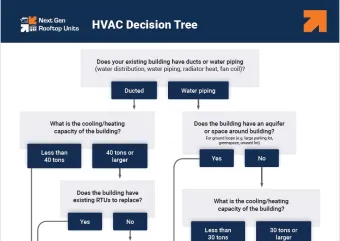View HVAC Decision Tree
First steps for a building owner choosing the right HVAC upgrade
HVAC systems play a big role in maintaining a building's comfort, efficiency, and air quality. As equipment reaches the end of its life cycle, upgrading presents an opportunity to improve indoor air quality, reduce energy costs, and enhance the overall performance of a building’s heating and cooling equipment. Determining the size and specifications of your existing system will help you and your contractor choose the best replacement option for your building’s needs.
How to determine equipment size using model number
Most equipment will have the cooling capacity of the unit built into the model number. Here’s how to decipher it:
- Locate the Model Number: It’s typically found on the exterior of outdoor equipment or behind the front cover on indoor equipment.
- Identify the Tonnage: Look for a number within the first six digits that is divisible by 12. Each “ton” of cooling is determined to be 12,000 btus/h.
- A 3-ton unit may have 36 in the model number to indicate tonnage.
- A 5-ton would have 60 and a 10-ton would have 120.
- Check for Half-ton Increments: If the model number does not have a number divisible by 12, it may be in increments of half tons. For example, the number 90 would indicate a 7.5-ton unit. There will not be tonnages in units smaller than half tons.
- Verify with Manufacturer Manuals: If the model number is not straightforward, check the manufactures online manual for a breakdown of the. Manufacturers have all their manuals online and free to download.
- Locate model number of equipment
- Search manufacturer name+ first three or four digits of model number (e.g. “Lennox ZGA Manual”).
- The manual will typically contain a page called “nomenclature” that will break down the specifications and optional features.
Next Steps
Once you’ve determined your equipment size and specifications, you’re ready to explore upgrade options! High efficiency options, like heat pump RTUs can provide better comfort, lower utility bills, and be a pathway to decarbonization goals. Use this information to help guide conversation with your HVAC contractor to help find the best solution for your building.
To simplify the decision-making process, follow the HVAC Decision Tree to explore the best upgrade options based on requirements.
